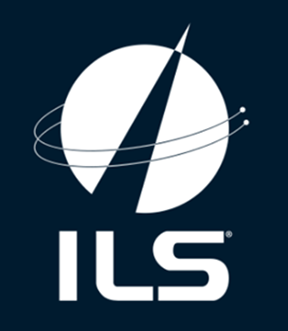
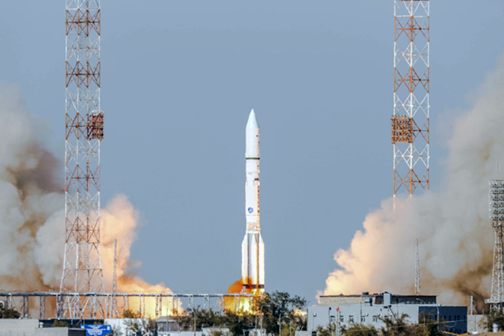
Lift-off of the EUTELSAT 5 West B and Mission Extension Vehicle-1 spacecrafts. Photo is courtesy of International Launch Services (ILS).
The EUTELSAT 5 West B satellite and the Mission Extension Vehicle-1 spacecraft were launched aboard a Proton-M launch vehicle by International Launch Services (ILS) from the Russian Baikonur launch center on October 9 at 15:17 (10:17 GMT / 12:17 CET / 06:17 EDT).
The EUTELSAT 5 West B is a Ku-band satellite that will locate at 5 degrees West, a key video neighborhood that addresses predominantly French, Italian and Algerian broadcast markets.
The new satellite will provide business continuity and improved quality for these markets via a Ku-band payload of 35 equivalent 36 MHz transponders connected to three service areas. Switchable transponders will also increase commercial flexibility.
Eutelsat selected Airbus Defence and Space and Northrop Grumman to build the new satellite. Airbus Defence and Space built the satellite’s payload while the platform was manufactured by Northrop Grumman.
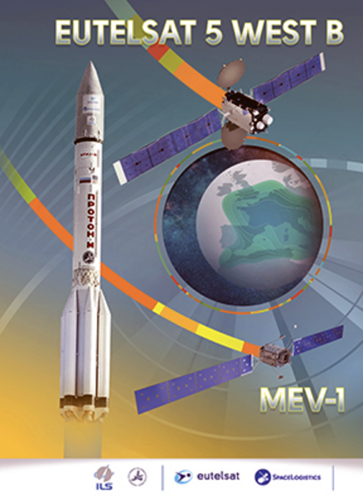
The Northrop Grumman-manufactured Mission Extension Vehicle-1 (MEV-1) delivers groundbreaking satellite life-extension services through the company’s subsidiary SpaceLogistics. MEV-1 docks to client vehicles in geosynchronous orbit using existing satellite features to provide attitude and orbit control of the combined vehicle stack.
MEV-1 has the ability to dock and undock several times during its 15 year design life, allowing it to service multiple customers. SpaceLogistics’ initial service, using the MEV-1, will extend the life of the Intelsat 901 satellite for five years. SpaceLogistics is pioneering the future of space by demonstrating the fundamentals of satellite servicing with MEV-1.
ILS released the following information regarding the company's successful launch...
International Launch Services (ILS) has successfully inserted the EUTELSAT 5 West B and the Mission Extension Vehicle-1 (MEV-1) satellites into their planned Supersynchronous Transfer Orbits (SSTO) for Eutelsat of Paris, France, and SpaceLogistics LLC of Dulles, Virginia.
This launch was the 97th ILS Proton mission and over 420 Proton launches overall. It is the eighth Eutelsat satellite launched on an ILS Proton and the first SpaceLogistics LLC satellite launched on an ILS Proton. It was also the second ILS dual launch, and the first dual launch with two commercial satellites.
The Proton Breeze M, using a 5-burn SSTO mission design, launched from Pad 39 at the Baikonur Cosmodrome on October 9 at 15:17 local time (10:17 GMT and 06:17 EDT). The satellites are both manufactured by Northrop Grumman and based on the GeoStar-2 (EUTELSAT 5 West B) and GeoStar-3 (MEV-1) platforms. The two spacecraft, making up the Integrated Payload Stack, weighed 5,190 kg at liftoff, and were separated 15 hours, 36 minutes (EUTELSAT 5 West B) and 15 hours, 54 minutes (MEV-1) after liftoff. Operators at the Northrop Grumman operations center in Dulles, Virginia acquired the spacecraft's first telemetry from orbit shortly after separation.
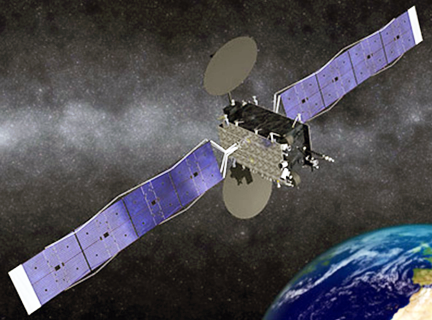
Artistic rendition of the Eutelsat 5 West B satellite.
EUTELSAT 5 West B is a Ku-band satellite that will be located at 5 degrees West, a key video neighborhood addressing predominantly French, Italian and Algerian broadcast markets. The new satellite will provide business continuity and improved quality for these markets via a Ku-band payload of 35 equivalent 36 MHz transponders connected to three service areas. Switchable transponders will also increase commercial flexibility.Grumman's wholly-owned subsidiary SpaceLogistics LLC. MEV-1 will dock to client vehicles in geosynchronous orbit to provide attitude and orbit control of the combined vehicle stack. MEV-1 has the ability to dock and undock several times during its 15 year design life, allowing it to service multiple customers. SpaceLogistics LLC's initial service, using MEV-1, will extend the life of the Intelsat 901 satellite for five years.
Since its maiden flight in 1965, the workhorse Proton vehicle has demonstrated its versatility, maturity and performance to inject spacecraft into a wide variety of orbits for a diverse customer base. The Proton Breeze M vehicle is developed and built by Khrunichev Research and Production Space Center (Khrunichev) of Moscow, Russia's premier space industry manufacturer and majority shareholder in ILS.
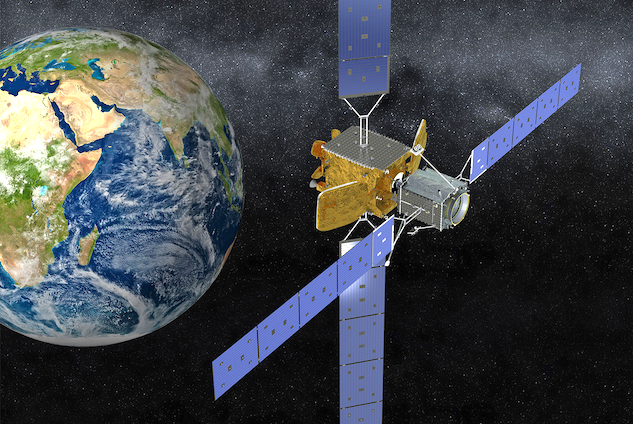
Artistic rendition of Northrop Grumman's MEV-1 spacecraft.
"The launch and eventual docking of MEV-1, the industry's first life extension vehicle, demonstrates Northrop Grumman's and SpaceLogistics' ability to innovate and deliver game changing technology. We are proud to have partnered with the ILS and Eutelsat teams who worked long and hard to ensure mission success," said Tom Wilson, President, SpaceLogistics LLC. "MEV-1 marks the first step towards introducing even more advanced on-orbit servicing capabilities and services for our customers."
ILS President Kirk Pysher said that, "ILS would like to extend the firm's heartfelt congratulations to the entire Eutelsat, Northrop Grumman, SpaceLogistics and Airbus Defence & Space teams on this outstanding success. He also thanked the teams at Roscosmos, Glavkosmos, GK Launch, Khrunichev, ILS and all of the various contractors and suppliers who support Proton and made this successful mission possible. This mission is Proton's 18th consecutive success bringing Proton's five year reliability to 95.6 percent. With today's added demonstration of Proton dual launch capability, ILS looks forward to supporting a broad range of changing spacecraft requirements."
Yohann Leroy, Deputy CEO and CTO at Eutelsat, said that, "Eutelsat is delighted to be back at Baikonur for another successful launch. The firm congratulates ILS and Khrunichev for this top-class dual 'stacked' launch. He thanked the company's partners Northrop Grumman and Airbus Defence and Space for their collaboration in creating this technological gem that will soon serve the French, Italian and Algerian markets with the highest quality video broadcasting. He also welcomed aboard EUTELSAT 5 West B the European GNSS Agency (GSA)'s EGNOS payload, set to greatly improve the accuracy of geolocation systems such as GPS or Galileo."

